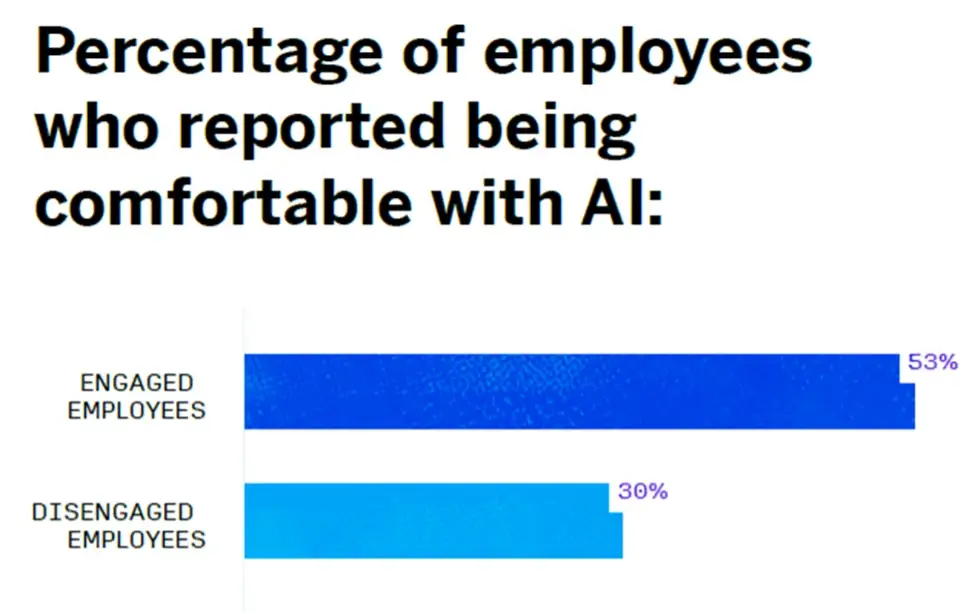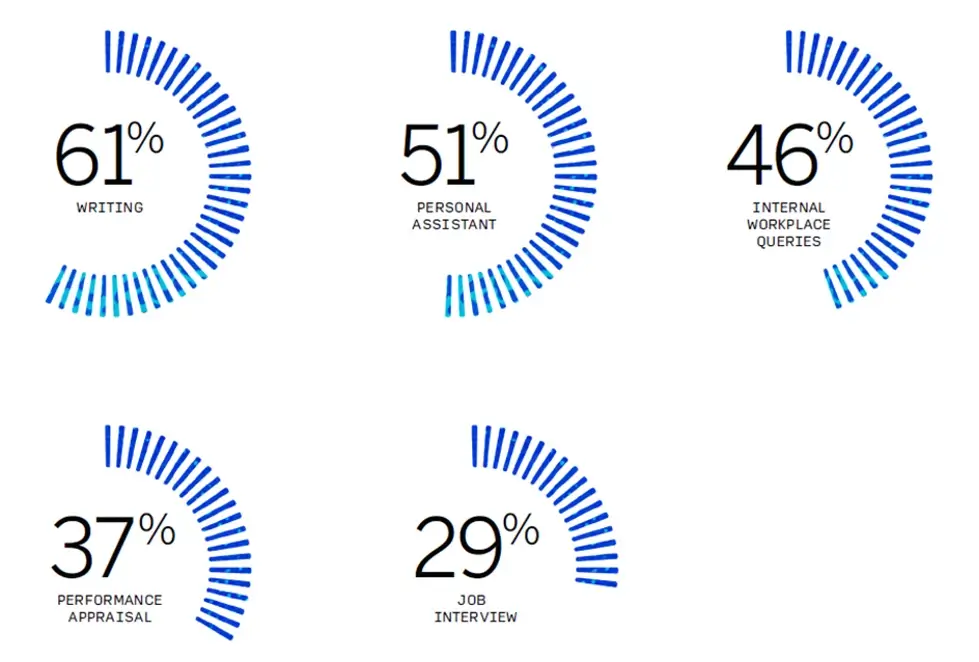
Employee engagement initiatives benefit everyone - from the CEO to the shop floor. Here are 6 surprising ones to help your employees feel valued.
Picture for a moment your ‘perfect’ job – a hybrid mixture of in-office and working from home, perhaps. You walk through the door on your first day, and everyone – from the manager to the intern - welcomes you warmly into the team. You settle into your well-equipped high-tech workstation with a work buddy and immediately get started on a task that you feel passionate about, that you feel will make a difference.
In team meetings, you feel you can ask any question and make any suggestion, without feeling judged or ignorant. Your manager sends you on training courses and you produce good work, made all the better by learning from mistakes, and your efforts get recognized and rewarded by leaders. You love being part of the office sports team and taking part in community volunteering days.
Sometimes, work can be challenging and tough, but it’s easy to let management know how you’re feeling because they ask continually, listen, then act quickly to put things right. If you feel overwhelmed and need a day off, it’s signed off without question, and you never miss your child’s sports day.
You enjoy high job satisfaction and wouldn’t consider working for anyone else.
You’re an engaged employee.
And unfortunately, you’re in the minority. Worldwide, 68% of employees are engaged in their work, which means that 32% of employees are quiet quitting, or disengaged from work. Employee disengagement affects the individual, their team, their organization, and even the global economy – to the tune of $8.8 trillion in 2022.
So what employee engagement strategies can you put in place to make your employees’ experiences as near to the one above as possible? You’re up against a demanding, yet eager workforce. Our 2024 EX Trends Report uncovered what today’s employees want and expect:
- They expect to use exciting new technology, including AI, but only if it’s used for good
- They want management to introduce policies and processes that empower them to work from both home and the office
- They expect to be heard (even opening up their work emails and Slack messages), they expect action to be taken on feedback, and they expect it to be for the common good of the organization and for the people
- They want to feel safe and respected, and to work with integrity
- They want to learn and develop, making use of their skills and abilities and meet career goals
Free eBook: Designing a world-class EX program that attracts and retains talent
What employee engagement programs can you put in place to satisfy the workplace of 2024?
Here are some of the most effective employee engagement initiatives:
1. Make sure managers are engaged
A workforce, try as hard as it might, cannot be engaged if its managers aren’t. Managers need to display infectious enthusiasm, and they cannot if they are exhausted, burnt out and disillusioned. And trust in management is at a low ebb – only 60% of frontline employees trust leadership. A good manager makes a work environment great by empowering team members to take responsibility, enabling them to do their job, and engaging them so that outcomes and goals are achieved.
You can give your managers the edge by:
- Lifting the burden of transactional tasks, such as managing scheduling, task allocation, performance tracking, goal-setting, and employee feedback.
- Giving them back the ‘human’ nuances of management – so they can focus on team building, giving employees involvement in goal setting, fostering a great company culture and elevating employee experience.
- Teaching them a new set of hybrid management skills for geographically dispersed teams: onboarding new members, managing the teams, setting and measuring performance targets, and observing, coaching and teaching the team remotely.
- Helping them listen to their employees: Only 53% of frontline employees feel they can challenge the traditional way of doing things to reach a better outcome for their customers, clients, or patients. Rather than being the ones with all the answers, managers must be curious about their team’s diverse, authentic perspectives, hear what they have to say and suggest, and act on it.
Tools such as our Manager Assist can help do the heavy lifting on all of these, to help boost employee engagement.
2. Onboard new hires well
With the hiring slowdown, our research found that organizations have become somewhat lax about giving a great onboarding experience, especially to remote workers. Yet it’s onboarding that sets the tone for the whole of an employee’s journey. More worryingly, we found that employees with less than six months of tenure have the lowest intent to stay (three years or more) at their organization: just 38% versus 65% overall.
So what can you do to prevent your expensively recruited, barely-ramped employees from leaving?
- Train managers to handle the needs of a dispersed or hybrid workforce; welcoming, regular check-ins, making them feel they are included and belong
- Use a designated onboarding survey program: all too often, ‘new’ employees are excluded from engagement surveys because it’s felt that they haven’t been with the company for long enough. Yet their feedback is crucial to make sure that new employee experiences line up with expectations – otherwise they’ll walk.
- Socialize new starters: whether employees are working in the office, remotely, or a mix of the two, getting to know team members is essential for your new hires to acclimatize, ramp up effectively, make connections, and learn how to navigate the organization’s cultural norms.
- Develop your new hires from day one: rather than ‘sitting with Nellie’ or going through work files, put your new employees straight onto a training program where they can learn from someone qualified, and not pick up bad habits.
Our People Lifecycle will help you consolidate all your employee feedback, automatically identify trends and risks amongst new employees, so you can improve experiences for everyone.
3. Support employee growth and development
Growth and development is a top driver of employee experience outcomes such as engagement, intent to stay, and avoiding burnout. With organizations working hard to reskill their workforces, they need to make sure every employee gets included. However, our research tells us that growth and development opportunities for new hires are scarce to non-existent.
How can you rectify that?
- Be more intentional about helping every new employee to make meaningful connections with their team members and the wider workforce.
- Map out clear pathways for every employee to grow and develop
- Understand the moments that matter along every employee’s journey to help you meet their expectations, increase engagement and give them more reasons to stay.
- Use software such as People Lifecycle which will consolidate feedback, identify trends and risks among your employee segments (including new hires) and highlight where you need to take action to grow and develop every employee
4. Embrace AI
AI is definitely a trend in employee experience, and despite fearmongering headlines and employee concerns, embracing AI can actually make your business more human, rather than less. And we found that the more engaged employees are, the more they’re willing to use AI at work:

AI can:
- Automate tedious, routine tasks, freeing up managers and teams to focus more innovation, creativity - and customers
- Improve collaboration by identifying co-workers whose skills and experience would work together well within a team
- Collect real time feedback through continuous employee listening - anonymized AI email and Slack monitoring that picks up on employee sentiment
- Assess employee engagement through analysis of the real time feedback
- Personalize learning and career development by combining data from employee surveys, performance reviews, 360 feedback, experience and qualifications to identify skills gaps and current knowledge
- Manage performance by setting goals, expectations and actual performance, delivering feedback to highlight where improvements need to be made
- Reduce bias, including unconscious bias in hiring, promotions, appraisals and salary reviews – leading to increased trust between leaders and employees and a culture of fairness throughout the organization.
Employees are more open to AI when they can see it’s directly helping them, and they can control it, but are less accepting when AI is evaluating them or impacting their career and livelihood.

To help AI enhance employee experience:
Explain, communicate and act
The more positive employees feel about their organization, and the more they trust it, and the more likely they are to believe that the organization will use AI for their benefit – to help them be more productive and efficient at their job.
Emphasize transparency, explain, and communicate what you’re doing with AI. In this way, organizations come across less ‘Big Brother’ and more as using it to improve employee-leader relationships. Text summarizers (where open comments are summarized rather than grouped into topics) help with keeping data more anonymous, especially for managers of small teams.
Discuss AI
We found that junior level workers, and new employees are the least comfortable with AI, whereas more senior employees are the most comfortable. Simply ask your people what they’re worried about, and explain the potential ways AI can make their jobs easier. And keep the conversation going as more developments in AI emerge.
Use AI to uncover experience gaps
AI-powered EX programs can help enhance every employee experience. AI can automatically link operational / behavioral data with survey results to track the impact of actions. You can enable frontline managers to understand their team more and how employees feel in real time, deliver personalized insights and recommendations to managers so they can close team experience gaps, and alert senior leaders to attrition risk before it accelerates.
Use our AI-powered Continuous Employee Listening; it includes powerful new employee sentiment analysis tools that lets you listen to what employees are saying, wherever they’re saying it.
5. Foster employee engagement with purpose
Profits at all costs are no longer cool. Think how damaging the VW emissions scandal, Rio Tinto’s destruction of the Juukan Gorge rock shelters, and PwC Australia’s tax scandal were to the brands - because what they did was simply wrong. Posting record profits at the expense of people and the planet is coming under increasing scrutiny.
And today’s employees really care about the integrity of their employer, placing importance on integrity and a high standard of values, even in tough times. Our 2023 research found that being employed is now more than just a job – it forms part of a person’s whole value system. When employer and employee values chime, employees are:
- 27% more likely to have higher engagement scores
- 23% more likely to stay working at the organization for more than 3 years
Keep employees engaged by:
Producing a purpose statement
This is different from a vision statement (where the company is going) and a mission statement (what the organization does, who it does it for and how it will do it). A purpose statement is why you do it, and how people will feel when they accomplish what they set out to achieve. It needs to reflect how your products and services improve the lives of the customers and businesses you serve – without trampling over others.
Issuing an ESG statement
ESG is bound up with purpose. It’s how an organization reassures society, consumers and investors that it’s trustworthy, making its employees proud that it is making a difference in the world. And when employees felt good about their organization’s contribution to their communities, they were:
- 15.6x more likely to recommend their company as a great place to work
- 1.9x more likely to feel proud of their organization
- 1.7x more likely to say they received a fair share of their organization’s profits
- 1.7x more likely to say their work means more than being ‘just a job’
Get a head start on gathering your stakeholders’ perspectives and make data-driven decisions on how to achieve your purpose and ESG objectives with our ESG solution.
5. Ensure psychological safety
Psychological safety is the ability to speak freely – and with conviction. Psychological safety at work occurs when employees feel a sense of belonging; when they’re able to bring their whole, authentic selves to the workplace and feel free to share their unique thoughts, feelings, ideas, questions, and mistakes without worrying they’ll be judged or made to feel inferior because of their contributions.
Make sure you:
- Offer a safe platform for employees to voice their opinion and know their concerns are met
- Establish clear norms, values and expectations to ensure predictability and fairness
- Encourage employees to communicate openly
- Actively listen to employees
- Make sure every team member feels supported
- Show appreciation and humility when people speak up and contribute
Psychological safety is an intrinsic part of the holistic employee experience, so it makes sense to measure it as part of your employee engagement program. Our EX25 Solution includes psychological safety as a metric.
6. Put wellbeing and work life balance first
There’s a strong link between employee engagement and employee wellbeing. Our 2023 EX Trends Report found that of employees who feel that they have a good work-life balance, almost two-thirds (63%) are willing to go above and beyond for their organization – something that only engaged employees will do.
In 2023, enablement and empowerment through efficient work processes were make-or-break for employee wellbeing. This year, employees want their jobs to make good use of their skills and abilities; to feel respected at work; to feel safe at work; and to work with integrity – in that order.
So what are two things you can do to improve wellbeing and work life balance?
Get hybrid right
Our 2024 EX Trends report found that those employees who work in the office 1-3 days a week report higher levels of inclusion and well-being than those who work fully remote or five days in the office. Make your RTO policies the best for employee wellbeing by asking your employees how they would like to work.
Give your people the right tech
Employees are being burned out because of inefficient systems and bad processes. There’s really no excuse today not to give your employees – in every department – the right tools to get their jobs done, collaborate, communicate, and manage their work life balance for optimum well being.
Encourage managers to lead with empathy
When managers are supportive, lead with empathy, and generally understand and know what’s going on in each employee’s work life, they support employee wellbeing. For employees juggling responsibilities and remote work, having positive relationships with managers who are aware of their situation at home, flexible and empathetic and enabling them to get work done will help them feel seen and heard.
Pulse surveys are your friends here: stay tuned into your employees’ changing needs by asking them how they feel and what they value – without burning them out – and acting on their feedback.
We hope we’ve given you some employee engagement ideas. Our XM for People Teams suite will help you make them a reality, so you can give power to your people - at every level.
Free eBook: Designing a world-class EX program that attracts and retains talent